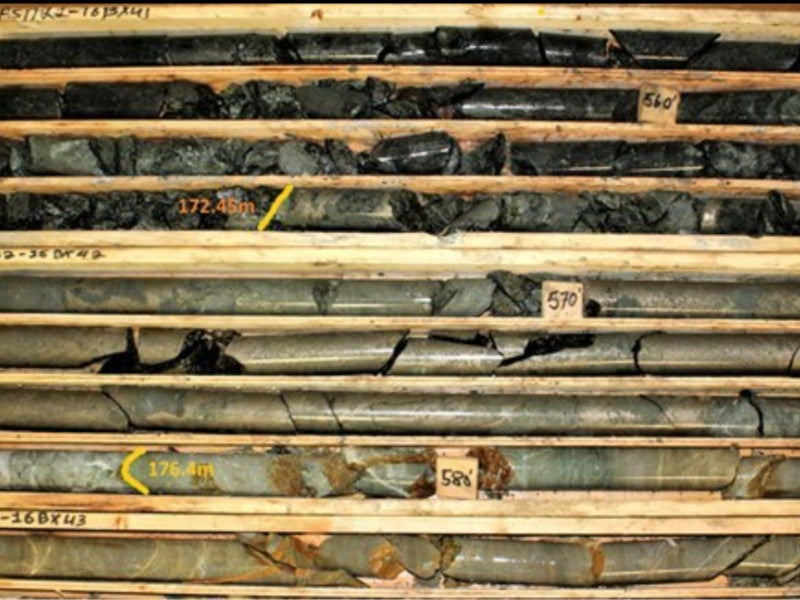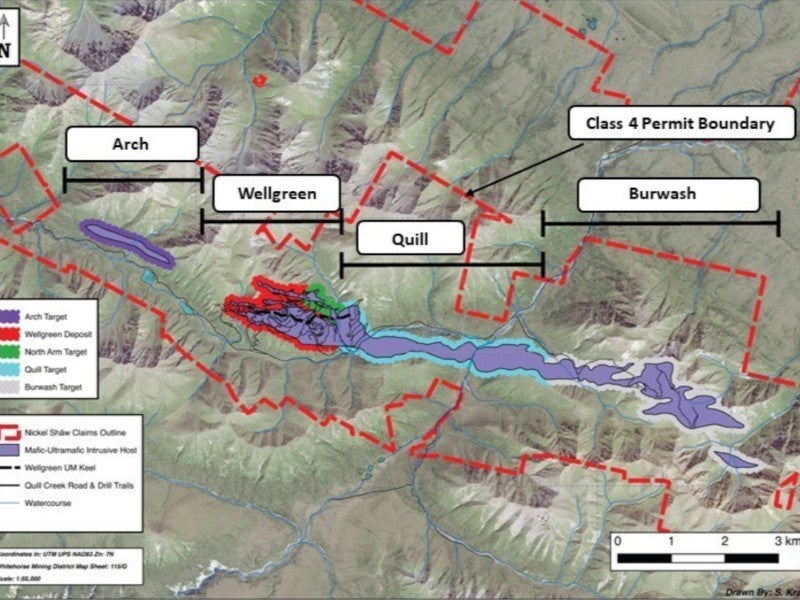The Nickel Shaw project is an open-pit mining development in the Yukon region of Canada. The project consists of nickel, copper and platinum group metals (Ni-Cu-PGM).
Nickel Creek Platinum, a Canadian exploration company based in Toronto, Canada, is developing the project. Nickel Creek holds 100% interest in the mineral rights of the project.
The pre-feasibility study, which focussed on the development of the Wellgreen deposit, was completed in August 2023.
The project is expected to have a mining life of 19.1 years with an estimated pre-production capital cost of $1.68bn.
Project location
The Nickel Shaw project is situated 317km northwest of Whitehorse in southwestern Yukon, Canada.
It encompasses 711 mineral claims covering 13,279ha, and 91 quartz mining leases covering 1,371ha.
Geology and mineralisation
The Nickel Shaw project is located within the Insular Superterrane, mainly composed of the Wrangellia Terrane and Alexander Terrane. Thick assemblages of oceanic sedimentary rocks overlay the island arc and ocean-floor volcanic rock terranes.
The project is part of the Kluane Ultramafic Belt, situated in the southwest portion of the Wrangellia Terrane. The Wellgreen deposit occurs within, and along, the lower margin of an Upper Triassic (Kluane) ultramafic-mafic body within the Quill Creek Complex.
Nickel and copper mineralisation at Wellgreen occurs within peridotite, clinopyroxenite and mineralised Quill Creek gabbro lithologies and is enclosed in relatively barren volcanoclastic and metasedimentary lithologies. Mineralisation occurs along a 1,700km strike length with thickness ranging from 20m to 300m in the west and east ends respectively.
Reserves
The proven and probable reserves at the Nickel Shaw project are estimated at 307.7 million tonnes (Mt), grading 0.26% nickel, 0.13% of copper, 0.014% cobalt, 0.04% gold, 0.22% platinum, 0.23% palladium, 16.8% magnesium and 0.67% sulphur as of July 2023.
Mining method
The Nickel Shaw Project will be developed as a conventional open-pit mine using drill and blast, load and haul methods. Mining operations will be carried out maintaining a strip ratio of 1.9:1 and using 10m benches. The current mining schedule involves two years of pre-stripping followed by 19 years of mining.
The mining fleet will include two 37m³ front shovels as the primary loading units, and one 21m³ front-end loader. The haul fleet will comprise up to 21 units of 240t trucks supported by an assortment of dozers, graders, and other support equipment graders.
Two 140mm drills, two 13m³ front-end loaders and five 91t trucks, in addition to support equipment, will be used at the quarry for building the tailings management facility.
The pit will be developed in three successive pushback phases. Phase One will provide the initial low-strip ratio mill feed, including a waste quarry designated as Phase One B, to the southwest of the Phase One pit. Phases two and three will extend to the western and higher areas of the pit.
Ore processing
The mineral processing plant will have a daily throughput rate of 45,000t. The run-of-mine (ROM) ore will undergo crushing in a primary gyratory crusher. The crushed ore will be stored in an uncovered stockpile with apron feeders discharging the material onto a semi-autogenous grinding (SAG) mill feed conveyor. The crushed mill feed will be ground to 80% passing 110µm using a single SAG mill and two parallel ball mills.
The ball mill discharge will pass through two cyclone clusters. The cyclone overflow will be conditioned prior to flotation.
The flotation circuit will include multiple stages of rougher, scavenger and cleaner flotation and also integrate a magnetic separation circuit for segregation of pyrrhotite. The flotation circuit will produce either a bulk Cu-Ni concentrate, or separate Cu and Ni concentrates based on the ROM ore feed.
In both cases, the resultant copper and nickel concentrate slurries will be pumped to a pressure filter for final dewatering. The copper and nickel filter cakes will be discharged automatically from the press via two cake discharge chutes. The cake product will then be transferred to the concentrate storage shed.
Tailings from the flotation circuit will be dewatered and thickened before being transported to the tailings management facility.
Site infrastructure
The project is accessible via the paved Alaska Highway, Highway 1 from where an all-weather, gravel road diverges southwest from the 1,727km marker and runs beside Quill Creek for 14km.
A 93MW, liquefied natural gas-fuelled power station is proposed to be constructed that will be designed, supplied, operated and maintained by a contractor under a turnkey power purchase agreement. The power plant will comprise seven natural gas turbines rated at 10MW each, and five steam turbine units each rated at 5MW. A proposal for wind power is also under assessment.
Water required for the drilling operations will be supplied by local creeks. Potable and non-potable water is sourced from a shallow well at the lower camp.
A 500-person camp is proposed to be installed to provide accommodation for construction and operations.
Contractors involved
The PFS was prepared by AGP Mining, a company based in Toronto, Canada.






